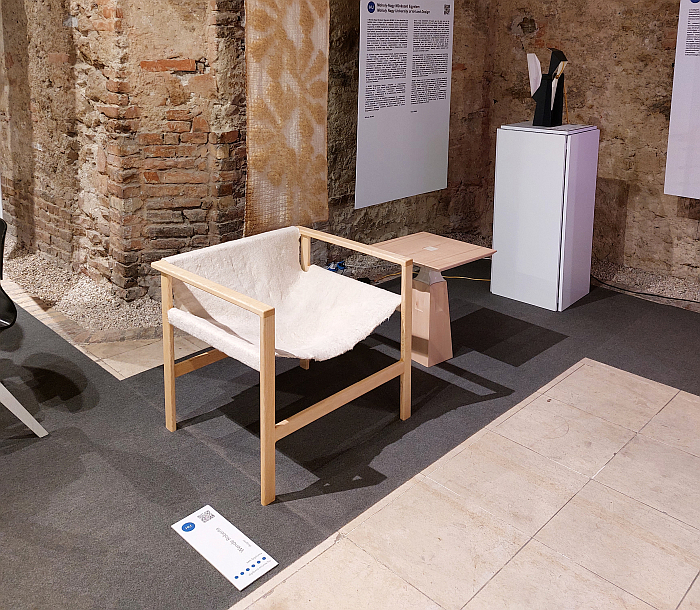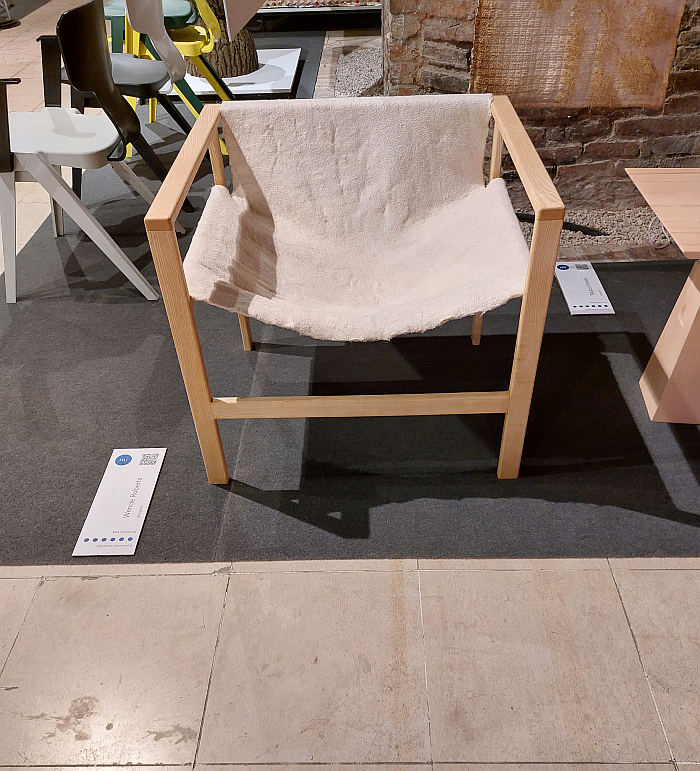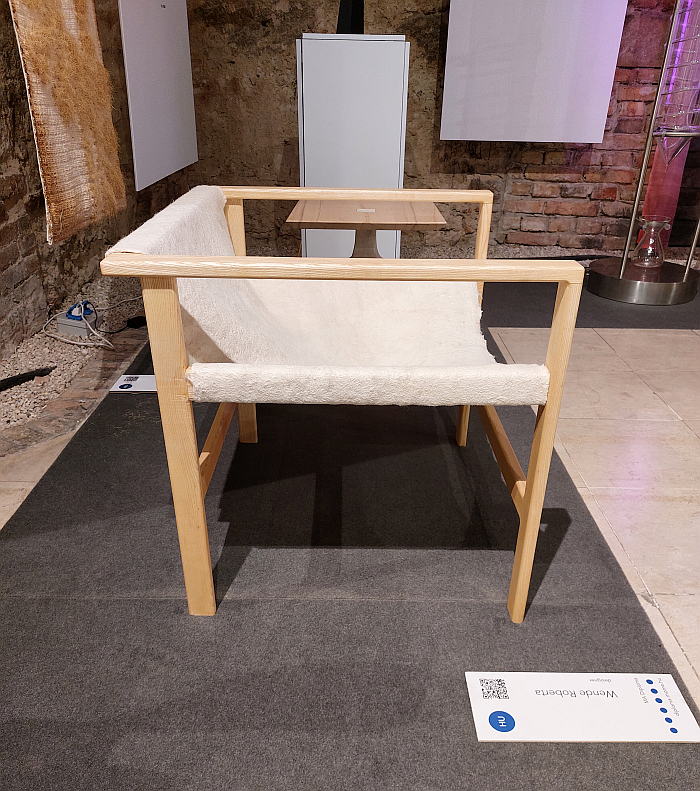
As the chair Moa by Roberta Wende appeared in our field of view at Design Without Borders 2024 in the Kiscell Museum, Budapest, our first thought was "felt". Or more accurately our first thought was "FELT!!!", a reflection of our current obsession with all things wool and the promise (we firmly believe to be) inherent in an increase in small-scale, local, sheep-holding in Europe.
And we were right it is felt. But not wool felt. Nor is Moa a chair. Although it very much is a chair.
Rather Moa is the physical expression of Roberta Wende's 2023 Masters thesis at the Moholy-Nagy University of Art and Design, Budapest, a thesis that concerned itself with "the link between natural fibres and raw-material-centred design with regards to the protection of regional traditions". Specifically in context of hemp. A material that, inarguably, would have been known and cultivated and employed in the lands of the contemporary Hungary during the 12th century when the Mariazell Basilica in Austria, which served as the model for the original Kiscell chapel from which the Kiscell Museum arose, was constructed; and was definitely known in the lands of the contemporary Hungary when that original Kiscell chapel was constructed in the 1720s.
An 18th century in which hemp was widely grown in Hungary, was widely grown across Central Europe; hemp being as it was over a great many centuries one of the most important raw materials in Europe for not just clothing textiles, but also, for example, for rope, paper or use in construction. In addition hemp seeds, and the oil won therefrom, were over just as many centuries important components of the European diet. And then, and summarising a little more than is prudent, the rise of cotton, for all as part of an increasingly globalised economy, saw demand for European hemp rapidly fall away from the mid 19th century, a fall whose trajectory became increasingly acute against the rapid rise of synthetic textiles in the mid 20th century. And a situation exacerbated by the near global ban on cannabis consumption in the 20th century, and the associated problems in growing hemp for its fibres, in being allowed to cultivate and process hemp. The associated problems of the authorities' inability to distinguish hemp from cannabis.
A hemp that is however very much still there in the contemporary Hungary, and a hemp which Roberta felted to create the material used in Moa's seat-shell; or more accurately needle felted to create the material used in Moa's seat-shell, a process that can be carried out from small-scale to industrial and which is a dry felting process, doesn't require water, a not unimportant consideration in context of the coming reality in which we will all have to live, work, survive. And a not unimportant consideration in context of cotton's water footprint and the question of which is more sustainable and responsible in a European context, hemp or cotton?
A renewable, locally producible and processable raw material with a relatively small footprint that can serve a wide variety of functions and from which, more ore less, every component is useable, that would appear to make hemp not only a future-orientated crop for Europe, but also one that offers local level benefits in Europe akin to those (we firmly believe to be) inherent in an increase in small-scale, local, sheep-holding. Benefits, of sheep and hemp, that Europe once had before the promises of industrialisation became blithely accepted and pathologically pursued. While also tending to imply that "protection of regional traditions" needn't necessarily mean ensuring that everything remains the way it has always been, or more probably, remains the way it has perceived to have been since time immemorial though probably wasn't, but that traditions can change as the realities in which they exist, and of which they are a component, change. Arguably tends to imply traditions must change, must evolve. The Hungary of the 2020s, the Europe of the 2020s, isn't the same as the Hungary/Europe of the 1720s. Why should the manner in which hemp is used?
Moa is thereby also a very nice reminder that the job of a designer isn't to design things that look good on social media. That's PR's jobs. Designers seek solutions to problems, challenge norms, conventions and perceptions, propose alternative realities, question, question and question again, re-imagine the existing, seek better ways to do that which is currently done, etc.
Thus Moa certainly isn't a chair.
Although it very much is a chair. Is clearly a chair. We saw it. Weren't able to sit in it and so can't make any comment on its sitting comfort and stability, nor how we gauge its durability: a free-hanging seat shell is obviously going to push any felt to its limits, but that doesn't mean it can't respond positively, doesn't mean it isn't up to the job. And, and without having read Roberta's thesis, we're fairly certain the material properties, also under duress, will have been explored and assessed as a component of that thesis, and are equally certain that in having crafted a free-hanging seat shell from hemp felt as part of her Masters thesis, Roberta has full faith in it. So why shouldn't we?
And despite our primary focus on the material, and despite not being able to sit in it and so assess the comfort and stability of the sit, as a chair it presents itself with a few interesting aspects, not least the strident quadraticness of its frame, it's frame's utter refusal to acknowledge the existence of the curve as a theoretical mathematical function, the frame's refusal to acknowledge lines that are anything but linear. And were also taken with its low slung feeling, a feeling largely mediated by the brevity of the gap between the seat shell and the top of the backrest, its almost non-existent. A brevity of gap between seat and backrest, and an unyielding quadraticness, very akin to the LC2 chair by Le Corbusier, Pierre Jeanneret & Charlotte Perriand, albeit without all the upholstery and baggage and protocol of a 19th century bourgeois parlour the LC2, for all its 20th century Modernity, seeks to maintain. And without the insistence one sit straight, without the didactic of the LC2.
Thoughts which bring one from an LC2 to a B3 by Roberta's fellow Hungarian Marcel Breuer, a work that rejects the upholstery and baggage and protocol of the past, preferring to work with the structural basics of a chair rather than polite society's expectations of a chair; albeit a B3 Roberta has tided up, tightened up, streamlined, gotten rid of the curves, ¿curves? ¿What are curves?, has reduced even more to the basics, but without forcing it into a rigid formality the B3 detests. The B3 doesn't want you to sit straight, nor does Moa. Or put another way, there is a very nice photo on the MOME Diploma page of Roberta, or someone, sat in Moa which very much leads one to understand that Moa is a chair for slouching in, it's not a work for formal occasions or a formal setting, but slouching in your own time according to your own rules. For lounging, but not in a formal lounge. For lounging in your space.
And a chair that through the materials of its construction, its attitude and it appreciations of sitting is a very approachable and engaging and open. And, quite possibly, comfortable. A chair that may or may not enable a Marcel Breuer's vision of sitting on a column of air.
But Moa isn't primarily a chair. Although it very much is a chair.
More information on Roberta Wende can be found on Instagram @robertawende.design and at www.behance.net
And more details on Design Without Borders, including information on the 2024 edition, can be found at https://design-without-borders.eu

